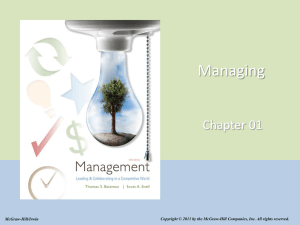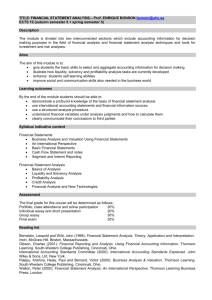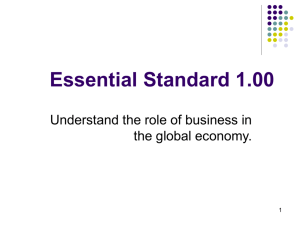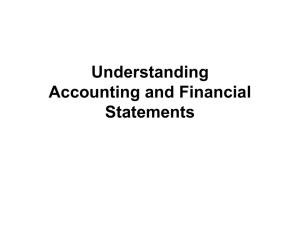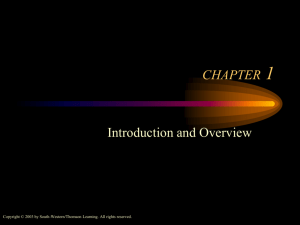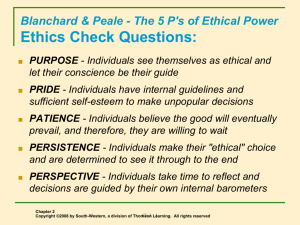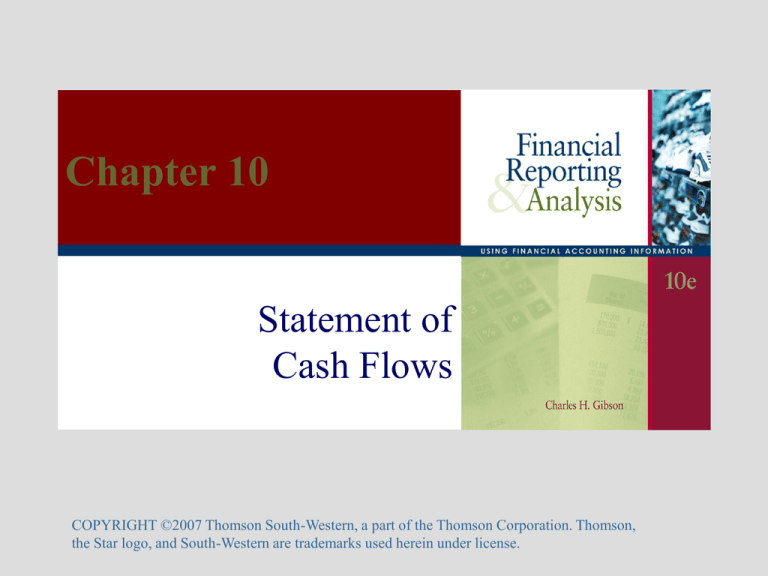
Chapter 10
Statement of
Cash Flows
COPYRIGHT ©2007 Thomson South-Western, a part of the Thomson Corporation. Thomson,
the Star logo, and South-Western are trademarks used herein under license.
Statement Use
• Internal users
– Determine dividend policy
– Evaluate cash generated by operations
– Review investing and financing policy
• External users
– Assess firm’s ability to increase dividends
– Assess firm’s ability to pay debt from operations
– Assess firm’s relationship of cash from operations
to total cash
Chapter 10, Slide #2
Copyright 2007 by Thomson South-Western, a part of The Thomson Corporation. All rights reserved.
Statement Structure
+
+
=
+
=
Cash flows from operations
Cash flows from investing activities
Cash flows from financing activities
Change in cash
Beginning cash balance
Ending cash balance
Chapter 10, Slide #3
Copyright 2007 by Thomson South-Western, a part of The Thomson Corporation. All rights reserved.
Operating Activities
The cash effects of transactions and other
events that enter into the determination of net
income:
Cash inflows from
• Sale of goods or
services
• Returns on loans
(interest)
• Return on equity
securities (dividends)
Cash outflows for
• Payments for
acquisitions of inventory
• Payments to employees
• Payments for taxes
• Payments for interest
• Payments for other
expenses
Chapter 10, Slide #4
Copyright 2007 by Thomson South-Western, a part of The Thomson Corporation. All rights reserved.
Investing Activities
Lending money and collecting on those loans
and acquiring and selling investments and
productive long-term assets:
Cash inflows from
• Receipts for loans
collected
• Sales of debt or equity
securities
• Sales of plant, property,
and equipment
Cash outflows for
• Loans to other entities
• Investment in debt or
equity securities
• Purchase of plant,
property, and
equipment
Chapter 10, Slide #5
Copyright 2007 by Thomson South-Western, a part of The Thomson Corporation. All rights reserved.
Financing Activities
Borrowing and repaying long-term loans;
issuing equity securities; payment of
dividends to shareholders:
Cash inflows from
• Sale of equity securities
• Sale of bonds,
mortgages, notes, and
other short- and longterm borrowings
Cash outflows for
• Payment of dividends
• Reacquisition of capital
stock
• Payment of amounts
borrowed
Chapter 10, Slide #6
Copyright 2007 by Thomson South-Western, a part of The Thomson Corporation. All rights reserved.
Cash Flows From Operations
• 2 methods for operating section of Cash Flow:
• Direct method
– Presents the income statement on a cash basis
– Supplemental information required: reconciliation
of net income to cash provided by operations
• Indirect method
– Adjusts net income for items that affected net
income but did not affect cash
– Supplemental information required: cash paid for
income taxes and for interest
– Most widely used
Chapter 10, Slide #7
Copyright 2007 by Thomson South-Western, a part of The Thomson Corporation. All rights reserved.
Cash Flows From Operations:
Direct Method
Cash flows from operations:
Cash received from customers
Cash paid to suppliers and employees
Interest received
Interest paid (net of amount capitalized)
Income taxes paid
Net cash provided by operations
$ 370,000
(310,000)
10,000
(4,000)
(15,000)
51,000
Presents the income statement on a cash basis
Chapter 10, Slide #8
Copyright 2007 by Thomson South-Western, a part of The Thomson Corporation. All rights reserved.
Cash Flows From Operations:
Indirect Method
Cash flows from operations:
Net earnings
$ 40,000
Provision for depreciation
6,000
Provision for allowance for doubtful accounts
1,000
Deferred income taxes
1,000
Loss on property, plant, and equipment disposals
2,000
Changes in operating assets and liabilities:
Receivables increase
(2,000)
Inventories increase
(4,000)
Accounts payable increase
5,000
Accrued income taxes increase
2,000
Net cash provided by operations
$51,000
Adjusts net income for items that affected net income
but did not affect cash
Chapter 10, Slide #9
Copyright 2007 by Thomson South-Western, a part of The Thomson Corporation. All rights reserved.
Cash Flows From Operations
Cash flows from operations:
Cash received from customers
Cash paid to suppliers and employees
Interest received
Interest paid (net of amount capitalized)
Income taxes paid
Net cash provided by operations
Indirect
$ 370,000
(310,000)
10,000
(4,000)
(15,000)
51,000
Direct
Cash flows from operations:
Net earnings
$ 40,000
Provision for depreciation
6,000
Provision for allowance for doubtful accounts
1,000
Deferred income taxes
1,000
Loss on property, plant, and equipment disposals
2,000
Changes in operating assets and liabilities:
Receivables increase
(2,000)
Inventories increase
(4,000)
Accounts payable increase
5,000
Accrued income taxes increase
2,000
Net cash provided by operations
$51,000
Chapter 10, Slide #10
Copyright 2007 by Thomson South-Western, a part of The Thomson Corporation. All rights reserved.
Cash Flows From Investing Activities
Cash flows from investing activities:
Capital expenditures
Proceeds from property, plant and equipment
disposals
Net cash used in investing activities
Chapter 10, Slide #11
Copyright 2007 by Thomson South-Western, a part of The Thomson Corporation. All rights reserved.
$ (30,000)
6,000
(24,000)
Cash Flows From Financing Activities
Cash flows from financing activities:
Net proceeds from repayment of
commercial paper
Proceeds from issuance of long-term debt
Dividends paid
Net cash used in financing activities
Chapter 10, Slide #12
Copyright 2007 by Thomson South-Western, a part of The Thomson Corporation. All rights reserved.
$ (4,000)
6,000
(5,000)
(3,000)
Statement of Cash Flows – Direct Method
(supplemental disclosures not illustrated)
OPERATING ACTIVITIES
Cash received from customers
Cash paid to suppliers and employees
Interest received
Interest paid
Income taxes paid
$ 370,000
(310,000)
10,000
(4,000)
(15,000)
Net cash provided (used) by operating activities
INVESTING ACTIVITIES
Capital expenditures
Proceeds from property, plant, and equipment
disposals
Net cash provided (used) by operating activities
FINANCING ACTIVITIES
Net proceeds from repayment of commercial paper
Proceeds from issuance of long-term debt
Dividends paid
Net cash provided (used) by financing activities
Increase in Cash
Beginning cash balance
Ending cash balance
$
Chapter 10, Slide #13
Copyright 2007 by Thomson South-Western, a part of The Thomson Corporation. All rights reserved.
51,000
(30,000)
6,000
(24,000)
(4,000)
6,000
(5,000)
(3,000)
24,000
8,000
32,000
Statement of Cash Flows – Indirect Method
(supplemental disclosures not illustrated)
OPERATING ACTIVITIES
Net earnings
Provision for depreciation
Provision for allowance for doubtful accounts
Deferred income taxes
Loss on property, plant, and equipment disposals
Changes in operating assets and liabilities:
Receivables increase
Inventories increase
Accounts payable increase
Accrued income taxes increase
$
(2,000)
(4,000)
5,000
2,000
Net cash provided (used) by operating activities
51,000
INVESTING ACTIVITIES
Capital expenditures
Proceeds from property, plant, and equipment
disposals
(30,000)
6,000
Net cash provided (used) by operating activities
FINANCING ACTIVITIES
Net proceeds from repayment of commercial paper
Proceeds from issuance of long-term debt
Dividends paid
(24,000)
(4,000)
6,000
(5,000)
Net cash provided (used) by financing activities
Increase in Cash
Beginning cash balance
Ending cash balance
40,000
6,000
1,000
1,000
2,000
(3,000)
$
24,000
8,000
32,000
Operating Cash Flow/Current Maturities of
Long-Term Debt and Current Notes Payable
Operating Cash Flow
Current Maturities of Long-Term Debt
and Current Notes Payable
• Indicates a firm’s abilities to meet its current
maturities of debt
• Higher ratio indicates better liquidity
Chapter 10, Slide #15
Copyright 2007 by Thomson South-Western, a part of The Thomson Corporation. All rights reserved.
Operating Cash Flow to Total Debt
Operating Cash Flow
Total Debt
• Indicates a firm’s ability to cover total debt with
the yearly operating cash flow
• Conservative approach is to include all
possible balance sheet debt
Chapter 10, Slide #16
Copyright 2007 by Thomson South-Western, a part of The Thomson Corporation. All rights reserved.
Operating Cash Flow per Share
Operating Cash Flow - Preferred Dividends
Diluted Weighted Average
Common Shares Outstanding
• A better indication of a firm’s ability to make
capital expenditure decisions and pay
dividends than is earnings per share
• Does not reflect firm’s profitability
– Firms are prohibited from reporting this statistic in
financial statements or in the notes thereto
Chapter 10, Slide #17
Copyright 2007 by Thomson South-Western, a part of The Thomson Corporation. All rights reserved.
Operating Cash Flow to Cash Dividends
Operating Cash Flow
Cash Dividends
• Indicates a firm’s ability to cover cash
dividends with the yearly operating cash flow
Chapter 10, Slide #18
Copyright 2007 by Thomson South-Western, a part of The Thomson Corporation. All rights reserved.
Procedures to Develop the Statement of
Cash Flows (cont’d)
1. Determine change in cash and cash
equivalents
2. Compute the change in all other balance
sheet accounts
3. Classify as operating, investing, and
financing
Chapter 10, Slide #19
Copyright 2007 by Thomson South-Western, a part of The Thomson Corporation. All rights reserved.
Procedures to Develop
Direct Operating Cash Flows
1. Operating section describes income
statement accounts as receipts or payments
2. Cash receipts
• From customers
• From other operating sources
3. Cash payments
• For merchandise
• To employees
• For other operating expenses
Chapter 10, Slide #20
Copyright 2007 by Thomson South-Western, a part of The Thomson Corporation. All rights reserved.
Procedures to Develop
Indirect Operating Cash Flows
1. Begin with net income
2. Eliminate gains and losses that relate to
investing and financing activities
3. Add back or deduct adjustments to change
accrual-based net income to cash basis
• Current noncash assets
• Current liabilities
Chapter 10, Slide #21
Copyright 2007 by Thomson South-Western, a part of The Thomson Corporation. All rights reserved.

